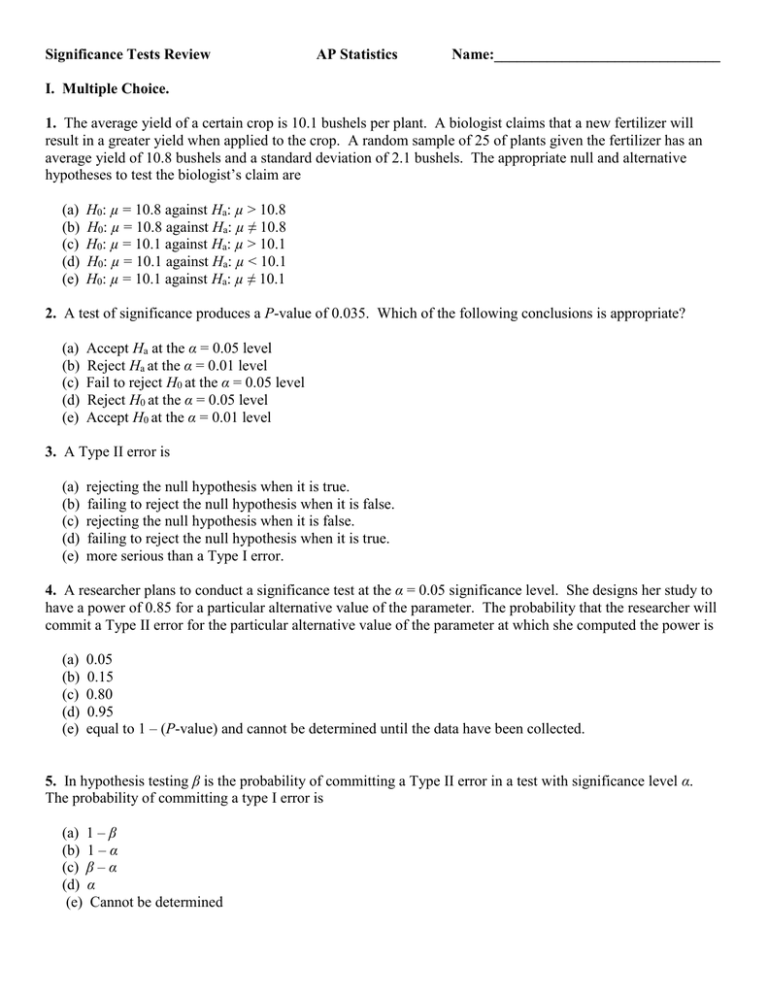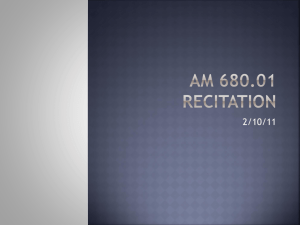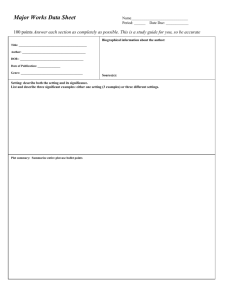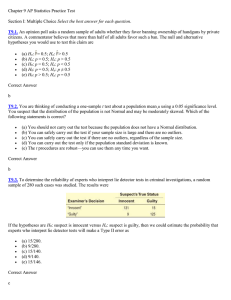Significance Tests Review AP Statistics For the following, define the
advertisement

Significance Tests Review AP Statistics Name:______________________________ I. Multiple Choice. 1. The average yield of a certain crop is 10.1 bushels per plant. A biologist claims that a new fertilizer will result in a greater yield when applied to the crop. A random sample of 25 of plants given the fertilizer has an average yield of 10.8 bushels and a standard deviation of 2.1 bushels. The appropriate null and alternative hypotheses to test the biologist’s claim are (a) (b) (c) (d) (e) H0: µ = 10.8 against Ha: µ > 10.8 H0: µ = 10.8 against Ha: µ ≠ 10.8 H0: µ = 10.1 against Ha: µ > 10.1 H0: µ = 10.1 against Ha: µ < 10.1 H0: µ = 10.1 against Ha: µ ≠ 10.1 2. A test of significance produces a P-value of 0.035. Which of the following conclusions is appropriate? (a) (b) (c) (d) (e) Accept Ha at the α = 0.05 level Reject Ha at the α = 0.01 level Fail to reject H0 at the α = 0.05 level Reject H0 at the α = 0.05 level Accept H0 at the α = 0.01 level 3. A Type II error is (a) (b) (c) (d) (e) rejecting the null hypothesis when it is true. failing to reject the null hypothesis when it is false. rejecting the null hypothesis when it is false. failing to reject the null hypothesis when it is true. more serious than a Type I error. 4. A researcher plans to conduct a significance test at the α = 0.05 significance level. She designs her study to have a power of 0.85 for a particular alternative value of the parameter. The probability that the researcher will commit a Type II error for the particular alternative value of the parameter at which she computed the power is (a) (b) (c) (d) (e) 0.05 0.15 0.80 0.95 equal to 1 – (P-value) and cannot be determined until the data have been collected. 5. In hypothesis testing β is the probability of committing a Type II error in a test with significance level α. The probability of committing a type I error is (a) 1 – β (b) 1 – α (c) β – α (d) α (e) Cannot be determined 6. The mean weight of a random sample of 35 athletes is found to be 165 pounds with a standard deviation of 20 pounds. It is believed that a mean weight of 160 pounds would be normal for this group. To see if there is evidence that the mean weight of the population of all athletes of this type is significantly higher than 160 pounds, the hypotheses H0: µ = 160 vs Ha: µ > 160 are tested. You obtain a P-value of 0.0742. Which of the following is true? (a) You have failed to obtain sufficient evidence against H0. (b) At the 5% significance level, you have proved that H0 is true. (c) At the 5% significance level, you have failed to prove that H0 is true, and a larger sample size is needed to do so. (d) Only 7.42% of the athletes weight less than 160 pounds. (e) None of the above. A significance test is inappropriate in this setting. 7. In a one-sided hypothesis test for the mean, for a random sample of size 15 the t-score of the sample mean is 2.615. Is this significant at the 5 percent level? At the 1 percent level? (a) (b) (c) (d) (e) Significant at the 1 percent level but not at the 5 percent level Significant at the 5 percent level but not at the 1 percent level Significant at both the 1 percent and 5 percent levels Significant at neither the 1 percent nor 5 percent levels Cannot be determined from the given information 8. You are thinking of conducting a one-sample t test about a population mean µ using a 0.05 significance level. Which of the following statements is correct? (a) (b) (c) (d) (e) You should not carry out the test if the sample does not have a Normal distribution. You can safely carry out the test if there are no outliers, regardless of the sample size. You can carry out the test if a graph of the data shows no strong skewness, regardless of the sample size. You can carry out the test only if the population standard deviation is known. You can safely carry out the test if your sample size is at least 30. 9. A random sample of 100 likely voters in a small city produced 59 voters in favor of Candidate A. The observed value of the test statistic for testing H0: p = 0.5 vs Ha: p > 0.5 is (a) 𝑧 = 0.59−0.5 (b) 𝑧 = 0.59(0.41) 100 √ 0.59−0.5 (c) 𝑧 = 0.5(0.5) 100 √ 0.5−0.59 (d) z= 0.5(0.5) √ 100 (e) 𝑡 = 0.5−0.59 0.59(0.41) 100 √ 0.59−0.5 0.5(0.5) 100 √ 10. An SRS of 100 postal employees found that the average time these employees had worked at the postal service was 7 years with standard deviation 2 years. Do these data provide convincing evidence the population of postal employees has changed from the value of 7.5 that was true 20 years ago? To determine this, we test the hypotheses H0: µ = 7.5 vs Ha: µ ≠ 7.5 using a one-sample t test. What conclusion should we draw at the 5% significance level? (a) (b) (c) (d) (e) There is convincing evidence that the mean time working with the postal service has changed. There is not convincing evidence that the mean time working with the postal service has change. There is convincing evidence that the mean time working with the postal service is still 7.5 years. There is convincing evidence that the mean time working with the postal service is now 7 years. We cannot draw a conclusion at the 5 % significance level. The sample size is too small. Multiple Choice Answers: 1. C, 2. D, 3. B, 4. B, 5. D, 6. A, 7. B, 8. E, 9. B, 10. A For questions 11 & 12, define the parameter of interest in context, and state appropriate hypotheses for performing a significance test. 11. The diameter of a spindle in a small motor is supposed to be 5 mm. If the spindle is either too small or too large, the motor will not work properly. The manufacturer measures the diameter in a sample of motors to determine whether the mean diameter has moved away from the target. 12. Mr. Starnes believes that less than 75% of the students at his school completed their math homework last night. The math teachers inspect the homework assignments form a random sample of students at the school to help Mr. Starnes test his claim. YOU WILL NEED TO USE YOUR OWN PAPER FOR THE REMAINDER OF THE REVIEW. For the following questions, make sure to show all of your work and indicate clearly the methods you use. 13. A software company is trying to decide whether to produce an upgrade of one of tis programs. Customers would have to pay $100 for the upgrade. For the upgrade to be profitable, the company needs to sell it to more than 20% of their customers. You contact a random sample of 60 customers and find that 16 would be willing to pay $100 for the upgrade. (a) Do the sample data give good evidence that more than 20% of the company’s customers are willing to purchase the upgrade? Carry out an appropriate test at the α = 0.05 significance level. (b) Which would be a more serious mistake in this setting – a Type I error or a Type II error? Justify your answer. (c) Describe two ways to increase the power of the test in part (a). 14. Bottles of a popular cola are supposed to contain 300 milliliters of cola. There is some variation from bottle to bottle because the filling machinery is not perfectly precise. An inspector measures the contents of six randomly selected bottles from a single day’s production. The results are 299.4 297.7 301.0 298.9 300.2 297.0 (a) Do these data provide convincing evidence that the mean amount of cola in all bottles filled that day differs from the target value of 300 ml? (b) Construct and interpret a 95% confidence interval for the population mean µ. What additional information does the confidence interval provide? 15. “I can’t get through my day without coffee” is a common statement from many students. Assumed benefits include keeping students awake during lectures and making them more alert for exams and tests. Students in a statistics class designed an experiment to measure memory retention with and without drinking a cup of coffee one hour before a test. This experiment took place on two different days in the same week (Monday and Wednesday). Ten students were used. Each student received no coffee or one cup of coffee one hour before the test on a particular day. The test consisted of a series of words flashed on a screen, after which the student had to write down as many of the words as possible. On the other day, each student received a different amount of coffee (none or one cup). (a) One of the researchers suggested that all the subjects in the experiment drink no coffee before Monday’s test and one cup of coffee before Wednesday’s test. Explain to the researcher why this is a bad idea and suggest a better method of deciding when each subject receives the two treatments. (b) The data from the experiment are provided in the table below. Set up and carry out an appropriate test to determine whether there is convincing evidence that drinking coffee improves memory. Student 1 2 3 4 5 6 7 8 9 10 No Cup 24 30 22 24 26 23 26 20 27 28 One Cup 25 31 23 24 27 25 28 20 27 30 Difference 16. A government report says that the average amount of money spent per U.S. household per week on food is about $158. A random sample of 50 households in a small city is selected, and their weekly spending on food is recorded. The sample data have a mean of $165 and a standard deviation of $20. Is there convincing evidence that the mean weekly spending on food in this city differs from the national figure of $158?





